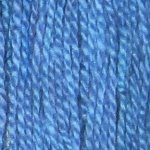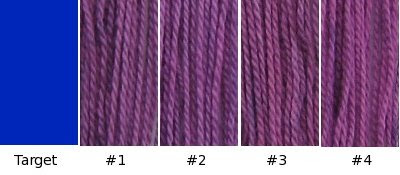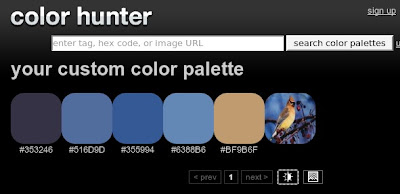Questions! (And my proposed answers.)
The first question is what to do with those numbers:

#0025B9
cyan - 1.0
magenta - 0.8
black - 0.28
Do they need to be percentages? Proportions? Weights?
To test the numbers on my various colors, I have been plugging them into the
Dye Mixer Applet. Sometimes the applet results matched the html sample, sometimes they didn't. After a little research, I have learned some interesting things about the applet in
this comment on Paula Burch's
Dye Forum. Namely, that the "mix amount" numbers only give approximate results. Considering the samples that didn't match, that's a relief. I also learned that those numbers don't indicate any specific unit of measurement. That's not a relief, that's a "now what."
The CMYK (cyan, magenta, yellow, & key black) color model that I'm trying to use, is for printing inks on paper. The numbers stand for percentages of each color. So for computer color #0025B9 (above), the printer would reproduce it on paper by using 100% cyan, 80% magenta, and 28% black inks. Obviously this cannot be translated directly into proportions for a dye recipe, because then I would have to be working with 208%.
For my first experiment I've decided to calculate these as percentages of their total 208. This gives me:
Cyan (for which I will substitute turquoise) - 48%
Magenta (for which I'll substitute fuchsia) - 38%
Black - 14%
Which lead me to another question, what unit of measurement? 48 teaspoons (or even 48 eighth teaspoons), is out of the question here in terms of dye amounts. And from what I have learned from the
DyersLIST archives, Procion MX dyes do not all weigh the same anyway. This means that a teaspoon of one color doesn't necessarily weigh the same as a teaspoon of another color. So, kitchen measurements are definitely out and metric measurements are definitely in.
The next question is on mixing. Do I mix the individual powders to make one dye stock, or do I make up individual dye stocks and then mix them? Considering that I will likely need to do quite a bit of sampling, mixing individual dye stocks makes more sense. Plus, it is safer to work with the dyes in solution rather than in powdered form. True, solutions won't keep all that long, but without the activator (soda ash), I should be able to use them up quickly enough.
And then there's the question of how well fuchsia will substitute for magenta and and turquoise for cyan. Also, which yellow is best? And what about black? There is no true Procion MX black as all the various blacks are mixtures of other colors. I think only experimentation can answer this for me.
Here's my plan:
- Measure mini-skeins of 12.5 grams each as samples. Based on the yards per pound, I have calculated that my yarn has 5.55 yards per gram, so I will need to measure out 69 and 1/3 yards per mini-skein.
- Mix up 1% stock solutions for the individual colors and mix the colors based on the percentages I calculated. I'm doing 1% instead of the usual 2% as it will be easier to work with the hex code numbers this way.
- Start with a dark depth of shade (dos), since the color #0025B9 (above) is a fairly deep blue. I will make adjustments from there.
Here are my calculations (from
this pdf help sheet from the University of Hertfordshire):
% shade ÷ % dye stock x WOF (dry weight of fabric) = total mls of dye stock
4% ÷ 1% x 12.5 gms = 50 mls total dye stock to add to dye bath
So for each color I need:
- Turquoise: 48% of 25 ml = 24 ml
- Fuchsia: 38% of 25 ml = 19 ml
- Black: 14% of 25 ml - 7 ml
One last question I have is based on some of the research I've been doing. That the depth of hue can vary amongst the various Procion MX colors, even if the same weight /amount of dye is being used. I hope I'm saying that right. I found this as a question in the DyersLIST archives, but with no clear answer. I've seen this somewhat with
my own experiments: I got a bright yellow but a softer red, even though I used the same amount of dye powder for each color. I got a red more equal in intensity to the yellow by doubling the amount of dye powder. Am I making sense? I'm probably not using all these terms accurately, but I hope you get my drift.
Anyway, I don't have any concrete facts to work with here, so I'm not going to worry about for now. I figure that I can't correct my course if I don't begin the journey.
I have absolutely no idea where I will end up colorwise, but at least I'm making a start.
Next ....
Computer Hex Code Dyeing 3: 1st Samples - No Joy
Related Posts:
Dye Recipes From Computer Color Codes: A Theory
Computer Hex Code Dyeing 1: Palettes From Pictures
Computer Hex Code Dyeing 3: 1st Samples - No Joy
Computer Hex Code Dyeing 4: 2nd Samples - Getting Closer
Computer Hex Code Dyeing 5: 1st Success?
Originally published July 9, 2008
 I will say with confidence that this is the closest I've gotten so far to my target blue. Is it exact? Even making allowances for the difference in media and electronic interpretations, I have to say no. Can I get any closer? I don't know.
I will say with confidence that this is the closest I've gotten so far to my target blue. Is it exact? Even making allowances for the difference in media and electronic interpretations, I have to say no. Can I get any closer? I don't know.
 The recipe used the same color proportions as I used for the sample on the right (turquoise MX-G, 76%; red MX-5B, 10%; and black MX-CWA, 14%.) With that series of samples, I experimented with adjusting the amounts of fuchsia and turquoise. This lighter blue sample was the closest match to my cedar waxwing photo.
The recipe used the same color proportions as I used for the sample on the right (turquoise MX-G, 76%; red MX-5B, 10%; and black MX-CWA, 14%.) With that series of samples, I experimented with adjusting the amounts of fuchsia and turquoise. This lighter blue sample was the closest match to my cedar waxwing photo.










































